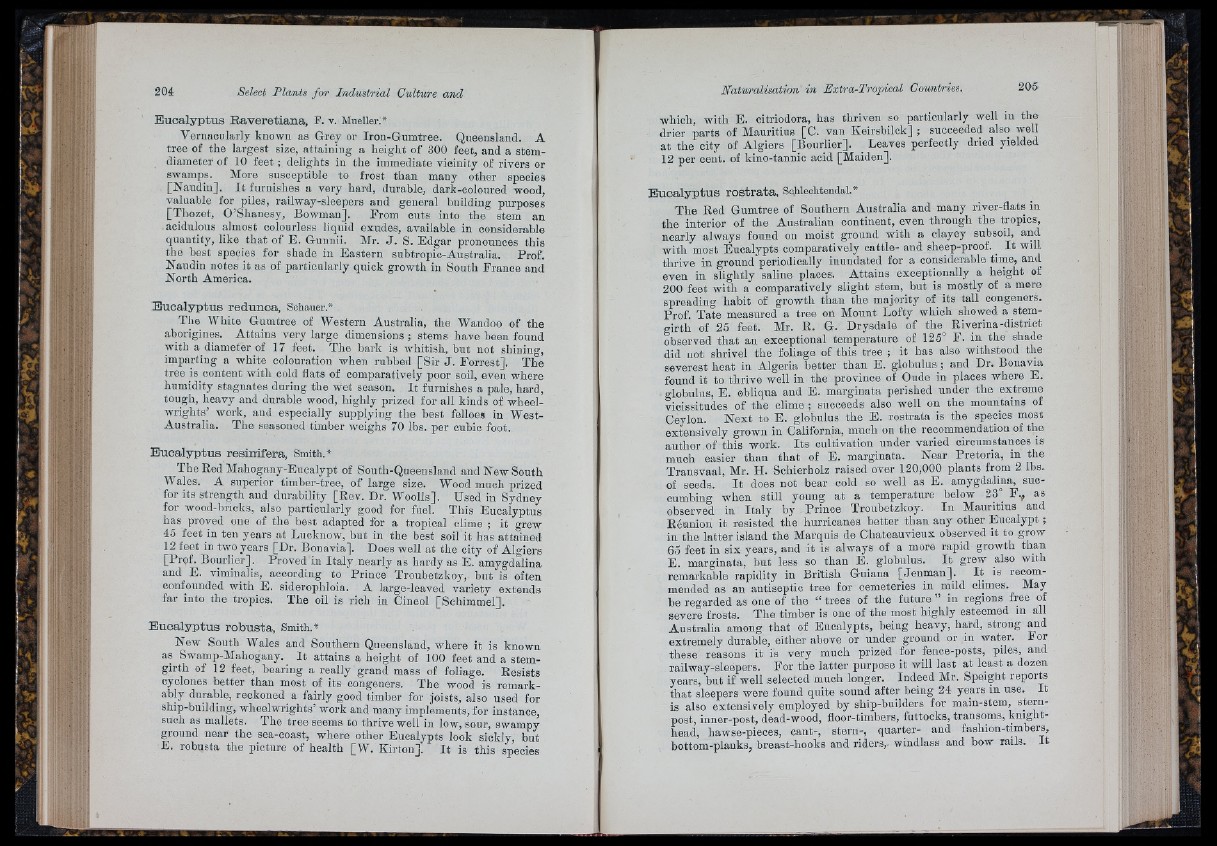
Eucalyptus Eaveretiana, F. v. Mueller.*
Vernacularly known as Grey or Iron-Gumtree. Queensland. A
tree of the largest size, attaining a height of 300 feet, and a stem-
diameter of 10 feet ; delights in the immediate vicinity of rivers or
swamps. More susceptible to frost than many other species
[Naudin]. I t furnishes a very hard, durable, dark-coloured wood,
valuable for piles, railway-sleepers aud general building purposes
[Thozet, O’Shanesy, Bowman], From cuts into the stem an
acidulous almost colourless liquid exudes, available in considerable
quantity, like th a t of E. Gunnii. Mr. J . S. Edgar pronounces this
the best species for shade iu Eastern subtropic-Austi’alia. Prof.
Naudin notes it as of particularly quick growth in South France and
North America.
Eucalyptus redunca, Sohauer.*
The White Gumtree of Western Australia, the Wandoo of the
aborigines. Attains very large dimensions ; stems have been found
with a diameter of 17 feet. The bark is whitish, but not shining,
imparting a white colouration when rubbed [Sir J . Forrest]. The
tree is content with cold fiats of comparatively poor soil, even where
humidity stagnates during the wet season. I t furnishes a pale, hard,
tough, heavy and durable wood, highly prized for all kinds of wheelwrights]
work, aud especially supplying the best felloes in West-
Australia. The seasoned timber weighs 70 lbs. per cubic foot.
Eucalyptus resinifera, Smith.*
The Red Mahogany-Eucalypt of South-Queensland and New South
Wales. A superior timber-tree, o f large size. Wood much prized
for its strength and durability [Rev. Dr. Woolls]. Used in Sydney
for wood-bricks, also particularly good for fuel. This Eucalyptus
has proved one of the best adapted for a tropical clime ; it grew
45 feet m ten years a t Lucknow, but in the best soil it has attained
12 feet in two years [Dr. Bonavia]. Does well at the city of Algiers
[Prof. Bourlier], Proved iu Ita ly nearly as hardy as E. amygdalina
and E. viminalis, according to Prince Troubetzkoy, but is often
confounded with E . siderophloia. A large-leaved variety extends
far into the tropics. The oil is rich in Cineol [Schimmel].
Eucalyptus robusta, Smith.*
New South Wales and Southern Queensland, where it is known
as Swamp-Mahogany. I t attains a height of 100 feet and a stem-
g irth of 12 feet, bearing a really grand mass of foliage. Resists
cyclones better than most of its congeners. The wood is remarkably
durable, reckoned a fairly good timber for joists, also used for
ship-building, wheelwrights’ work and many implements, for instance,
such as mallets. The tree seems to thrive well in low, sour, swampy
ground near the sea-coast, where other Eucalypts look sickly, but
E. robusta the picture of health [W. Kirton], I t is this species
t:-:
which, with E. citriodora, has thriven so particularly well in th e
drier parts of Mauritius [C. van Keirsbilok] ; succeeded also well
at the city of Algiers [Bourlier]. Leaves perfectly dried yielded
12 per cent, of kino-tannic acid [Maiden].
Eucalyptus rostrata, Schlechtendal.*
The Red Gumtree of Southern Australia and many river-flats in
the interior of the Australian continent, even through the tropics,
nearly always found on moiti ground with a clayey subsoil, and
with most Eucalypts comparatively cattle- and sheep-proof. ^ I t will
thrive in ground periodically inundated for a considerable time, and
even in slightly saline places. Attains exceptionally a height of
200 feet with a comparatively slight stem, but is mostly of a mere
spreading habit of growth than the majority of its tall congeners.
Prof. Tate measured a tree on Mount Lofty which showed a stem-
g irth of 25 feet. Mr. E . G. Drysdale of the^ Riverina-district
observed th a t an exceptional temperature of 125° P. in the shade
did not shrivel the foliage of this tree ; it has also withstood the
severest heat in Algeria better than E. globulus ; and Dr. Bonavia
found it to thrive well in the province of Oude in places where E.
globulus, E. obliqua and E. marginata perished under the extreme
vicissitudes of the clime ; succeeds also well on the mountains of
Ceylon. N ex t to E . globulus the E. rostrata is the species most
extensively grown in California, much on the recommendation of the
author of this work. Its cultivation under varied circumstances is
much easier than th a t of B. marginata. Near Pretoria, in the
Transvaal, Mr. H. Schierholz raised over 120,000 plants from 2 lbs.
of seeds. I t does not bear cold so well as E. amygdalina, succumbing
when still young a t a temperature below 23° F.^, as
observed in Ita ly by Prince Troubetzkoy. In Mauritius and
Reunion it resisted the hurricanes better than any other Eucalypt
in the latter island the Marquis de Chateauvieux observed it to grow
65 feet in six yea.rs, and it is always of a more rapid growth than
E . marginata, but less so than E . globulus. I t grew also with
remarkable rapidity in British Guiana [Jenm an ]. I t is
mended as an antiseptic tree for cemeteries in mild climes. May
he regarded as one of the “ trees of the future ” in regions free of
severe frosts. The timber is one of the most highly esteemed in all
Australia among th a t of Eucalypts, being heavy, hard, strong and
extremely durable, either above or under ground or m water. I or
these reasons it is very much prized for fence-posts, piles, and
railway-sleepers. For the latter purpose it will last at least a dozen
years, but if well selected much longer. Indeed Mr. Speight reports
th a t sleepers were found quite sound after being 24 years in use. I t
is also extensively employed by ship-builders for main-stem, stern-
post, inner-post, dead-wood, floor-timbers, futtocks, transoms, knight-
head, hawse-pieoes, cant-, stern-, quarter- and fashion-timbers,
bottom-plauks, breast-hooks and riders, windlass and bow rails. I t
j ;
■ fr: : .